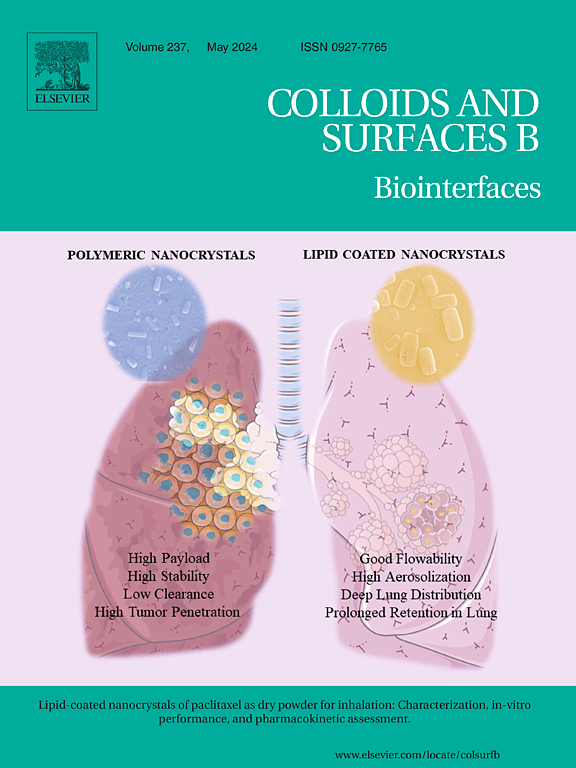Construction of bilayer biomimetic periosteum based on SLA-3D printing for bone regeneration
IF 5.4
2区 医学
Q1 BIOPHYSICS
引用次数: 0
Abstract
An ideal biomimetic periosteum should have excellent biocompatibility to promote osteoclast adhesion and improve osseointegration, which is significant in promoting bone regeneration. In this work, a bionic artificial periosteum printed by the SLA-3D printing was prepared, consisting of a poly (ethylene glycol) diacrylate (PEGDA)/chitosan/tricalcium phosphate (TCP) fibrous layer and a gelatin methacryloyl (GelMA)/ammonium molybdate (Mo) cambium layer. Distinct surface characteristics were achieved on both sides of the biomimetic periosteum. Among them, the fibrous layer has high mechanical properties and low porosity, which is conducive to preventing the pulling of muscle tissues and the invasion of soft tissues. The cambium layer has a porous structure and bioactive factors that can effectively promote osteogenic differentiation of preosteoblasts. Combined with mild photothermal therapy triggered by NIR light, the biomimetic periosteum could promote bone regeneration at both the chemical and physical levels. This 3D-printed bilayer hydrogel can provide a promising strategy for preparing advanced tissue-engineered periosteum with excellent physical and bone regeneration properties.
基于 SLA-3D 打印技术构建用于骨再生的双层仿生骨膜。
理想的仿生骨膜应具有良好的生物相容性,以促进破骨细胞粘附并改善骨结合,这对促进骨再生意义重大。本研究采用 SLA-3D 打印技术制备了一种仿生人工骨膜,由聚(乙二醇)二丙烯酸酯(PEGDA)/壳聚糖/磷酸三钙(TCP)纤维层和明胶甲基丙烯酰(GelMA)/钼酸铵(Mo)骨膜层组成。仿生骨膜的两面都具有不同的表面特征。其中,纤维层具有较高的机械性能和较低的孔隙率,有利于防止肌肉组织的牵拉和软组织的侵入。骨膜层具有多孔结构和生物活性因子,能有效促进前成骨细胞的成骨分化。结合近红外光引发的温和光热疗法,仿生骨膜可在化学和物理层面促进骨再生。这种三维打印双层水凝胶为制备具有优异物理和骨再生特性的先进组织工程骨膜提供了一种前景广阔的策略。
本文章由计算机程序翻译,如有差异,请以英文原文为准。
求助全文
约1分钟内获得全文
求助全文
来源期刊

Colloids and Surfaces B: Biointerfaces
生物-材料科学:生物材料
CiteScore
11.10
自引率
3.40%
发文量
730
审稿时长
42 days
期刊介绍:
Colloids and Surfaces B: Biointerfaces is an international journal devoted to fundamental and applied research on colloid and interfacial phenomena in relation to systems of biological origin, having particular relevance to the medical, pharmaceutical, biotechnological, food and cosmetic fields.
Submissions that: (1) deal solely with biological phenomena and do not describe the physico-chemical or colloid-chemical background and/or mechanism of the phenomena, and (2) deal solely with colloid/interfacial phenomena and do not have appropriate biological content or relevance, are outside the scope of the journal and will not be considered for publication.
The journal publishes regular research papers, reviews, short communications and invited perspective articles, called BioInterface Perspectives. The BioInterface Perspective provide researchers the opportunity to review their own work, as well as provide insight into the work of others that inspired and influenced the author. Regular articles should have a maximum total length of 6,000 words. In addition, a (combined) maximum of 8 normal-sized figures and/or tables is allowed (so for instance 3 tables and 5 figures). For multiple-panel figures each set of two panels equates to one figure. Short communications should not exceed half of the above. It is required to give on the article cover page a short statistical summary of the article listing the total number of words and tables/figures.
 求助内容:
求助内容: 应助结果提醒方式:
应助结果提醒方式:


